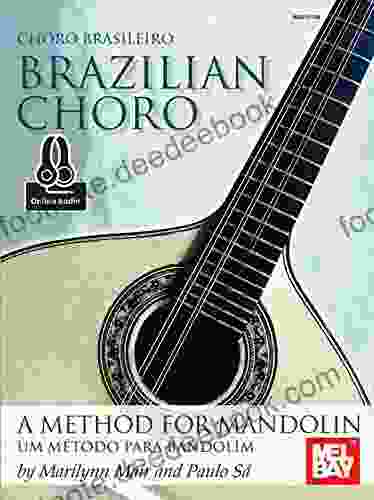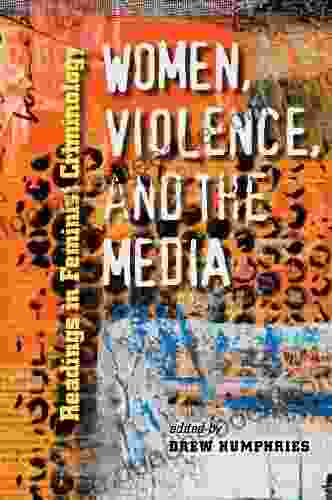Exploring the Brazilian Choro Method for Mandolin and Bandolim: A Comprehensive Guide

Choro is a genre of Brazilian music that emerged in the late 19th century. It is characterized by its lively rhythms, syncopated melodies, and improvisational elements. Choro is typically played by a small ensemble of instruments, including the mandolin, bandolim, guitar, and cavaquinho.
The mandolin and bandolim are both stringed instruments that are commonly used in choro music. The mandolin is a small, round-bodied instrument that is typically played with a pick. The bandolim is a larger, oval-bodied instrument that is played with a plectrum.
The choro method for mandolin and bandolim is a unique approach to playing these instruments that has been developed over many years by Brazilian musicians. This method emphasizes the use of syncopated rhythms, improvisation, and ornamentation.
4.4 out of 5
| Language | : | English |
| File size | : | 1540 KB |
| Text-to-Speech | : | Enabled |
| Screen Reader | : | Supported |
| Enhanced typesetting | : | Enabled |
| Word Wise | : | Enabled |
| Print length | : | 185 pages |
| Lending | : | Enabled |
The choro method for mandolin and bandolim emerged in the late 19th century in Rio de Janeiro, Brazil. The first known choro musicians were a group of amateur musicians who played for their own enjoyment. These musicians were influenced by a variety of musical styles, including Portuguese fado, African samba, and European classical music.
In the early 20th century, choro began to gain popularity as a professional music genre. Choro musicians began to perform in concert halls and recording studios. This led to the development of a more formalized method of playing the mandolin and bandolim.
The choro method for mandolin and bandolim was further developed in the 1940s and 1950s by a group of musicians who were known as the "Choro Masters." These musicians included Jacob do Bandolim, Waldir Azevedo, and Dinorá de Carvalho. The Choro Masters developed new techniques for playing the mandolin and bandolim, and they also began to teach their methods to other musicians.
Today, the choro method for mandolin and bandolim is still taught by many musicians in Brazil. This method is considered to be an essential part of the choro tradition.
The choro method for mandolin and bandolim is based on the use of syncopated rhythms, improvisation, and ornamentation.
Syncopated rhythms are rhythms that are played against the beat. This creates a sense of movement and energy in the music.
Improvisation is the ability to create music spontaneously. Choro musicians often improvise solos and countermelodies over the basic chord progression.
Ornamentation is the use of decorative notes to embellish the melody. Choro musicians often use trills, turns, and grace notes to add interest to their playing.
In addition to these three basic techniques, the choro method for mandolin and bandolim also includes a number of other techniques, such as:
- Tremolo picking
- Rasgueado strumming
- Pizzicato plucking
- Harmonics
The repertoire of the choro method for mandolin and bandolim includes a wide variety of pieces, from traditional choro waltzes and polkas to more modern compositions.
Some of the most popular choro pieces include:
- "Carinhoso" by Pixinguinha
- "Brasileirinho" by Waldir Azevedo
- "Tico-Tico no Fubá" by Zequinha de Abreu
- "Odeon" by Ernesto Nazareth
- "Aquarela do Brasil" by Ary Barroso
Choro music is often performed at social gatherings, such as parties and weddings. It is also played in concert halls and recording studios.
The choro method for mandolin and bandolim is a unique and vibrant approach to playing these instruments. This method is based on the use of syncopated rhythms, improvisation, and ornamentation. The repertoire of the choro method includes a wide variety of pieces, from traditional choro waltzes and polkas to more modern compositions.
If you are interested in learning how to play mandolin or bandolim, the choro method is a great place to start. This method will help you to develop your skills as a musician and to appreciate the rich tradition of Brazilian choro music.
4.4 out of 5
| Language | : | English |
| File size | : | 1540 KB |
| Text-to-Speech | : | Enabled |
| Screen Reader | : | Supported |
| Enhanced typesetting | : | Enabled |
| Word Wise | : | Enabled |
| Print length | : | 185 pages |
| Lending | : | Enabled |
Do you want to contribute by writing guest posts on this blog?
Please contact us and send us a resume of previous articles that you have written.
 Book
Book Page
Page Chapter
Chapter Reader
Reader Library
Library Paperback
Paperback E-book
E-book Magazine
Magazine Paragraph
Paragraph Sentence
Sentence Glossary
Glossary Bibliography
Bibliography Foreword
Foreword Tome
Tome Classics
Classics Library card
Library card Narrative
Narrative Biography
Biography Autobiography
Autobiography Memoir
Memoir Encyclopedia
Encyclopedia Narrator
Narrator Resolution
Resolution Librarian
Librarian Card Catalog
Card Catalog Stacks
Stacks Study
Study Scholarly
Scholarly Reserve
Reserve Academic
Academic Journals
Journals Reading Room
Reading Room Special Collections
Special Collections Interlibrary
Interlibrary Literacy
Literacy Study Group
Study Group Dissertation
Dissertation Storytelling
Storytelling Theory
Theory Textbooks
Textbooks Charae Lewis
Charae Lewis Peter Rosch
Peter Rosch Stuart Taylor
Stuart Taylor Kirstin Chen
Kirstin Chen Thomas Elliott Young
Thomas Elliott Young Sebastian A Jones
Sebastian A Jones Bernadette Mcdonald
Bernadette Mcdonald Armin Nassehi
Armin Nassehi Carolyn Keene
Carolyn Keene Conrad Birmingham
Conrad Birmingham Dan Robinson
Dan Robinson Michael Palmer
Michael Palmer Kathryn Freeman
Kathryn Freeman Kevin Attis
Kevin Attis Megan Stephens
Megan Stephens Charlotte Mason
Charlotte Mason Ezra Pound
Ezra Pound Michael Kirby
Michael Kirby William Mccauley
William Mccauley Raeanne Thayne
Raeanne Thayne
Light bulbAdvertise smarter! Our strategic ad space ensures maximum exposure. Reserve your spot today!
 Chris ColemanFollow ·5.6k
Chris ColemanFollow ·5.6k Maurice ParkerFollow ·14.1k
Maurice ParkerFollow ·14.1k Howard BlairFollow ·3.7k
Howard BlairFollow ·3.7k Osamu DazaiFollow ·4k
Osamu DazaiFollow ·4k Douglas PowellFollow ·18.7k
Douglas PowellFollow ·18.7k Lucas ReedFollow ·2.3k
Lucas ReedFollow ·2.3k Franklin BellFollow ·6.5k
Franklin BellFollow ·6.5k Devon MitchellFollow ·14.6k
Devon MitchellFollow ·14.6k

 Allen Ginsberg
Allen GinsbergUnveiling the True Meaning of Enough: A Comprehensive...
: In the relentless pursuit of progress and...

 Clay Powell
Clay PowellHawker Hunter: The Jet Fighter that Shaped British...
Nestled in the halls of aviation...

 Alec Hayes
Alec HayesWhen and How to Use Lean Tools and Climb the Four Steps...
Lean is a management...

 Trevor Bell
Trevor BellVolume of Charlotte Mason Original Homeschooling: A...
Charlotte Mason's original...

 John Parker
John ParkerAscending Tristan da Cunha: A Comprehensive Guide to...
Prepare yourself for an extraordinary journey...
4.4 out of 5
| Language | : | English |
| File size | : | 1540 KB |
| Text-to-Speech | : | Enabled |
| Screen Reader | : | Supported |
| Enhanced typesetting | : | Enabled |
| Word Wise | : | Enabled |
| Print length | : | 185 pages |
| Lending | : | Enabled |














